UK & Nigeria: Factors Influencing Contingency Sum Estimation
VerifiedAdded on 2023/04/20
|41
|9424
|257
Report
AI Summary
This report investigates the factors influencing contingency sum estimation in construction contracts within the UK and Nigeria, addressing the problem of cost overruns and the accuracy of estimations. It explores various contingency estimation methods, including deterministic estimation, regression, Monte Carlo simulation, and artificial neural networks. Key attributes such as risk, risk management, total commitments, and project outcomes are examined, alongside different categories of contingencies like design and construction contingencies. The research methodology involves questionnaires, secondary data review, and case studies to analyze factors influencing contingency sum estimation in Nigeria, the estimation of percentage contingencies, project cost data presentation, and best practices in the construction industry, including green technology. The report concludes with recommendations for accurate contingency sum estimation and adherence to global best practices.
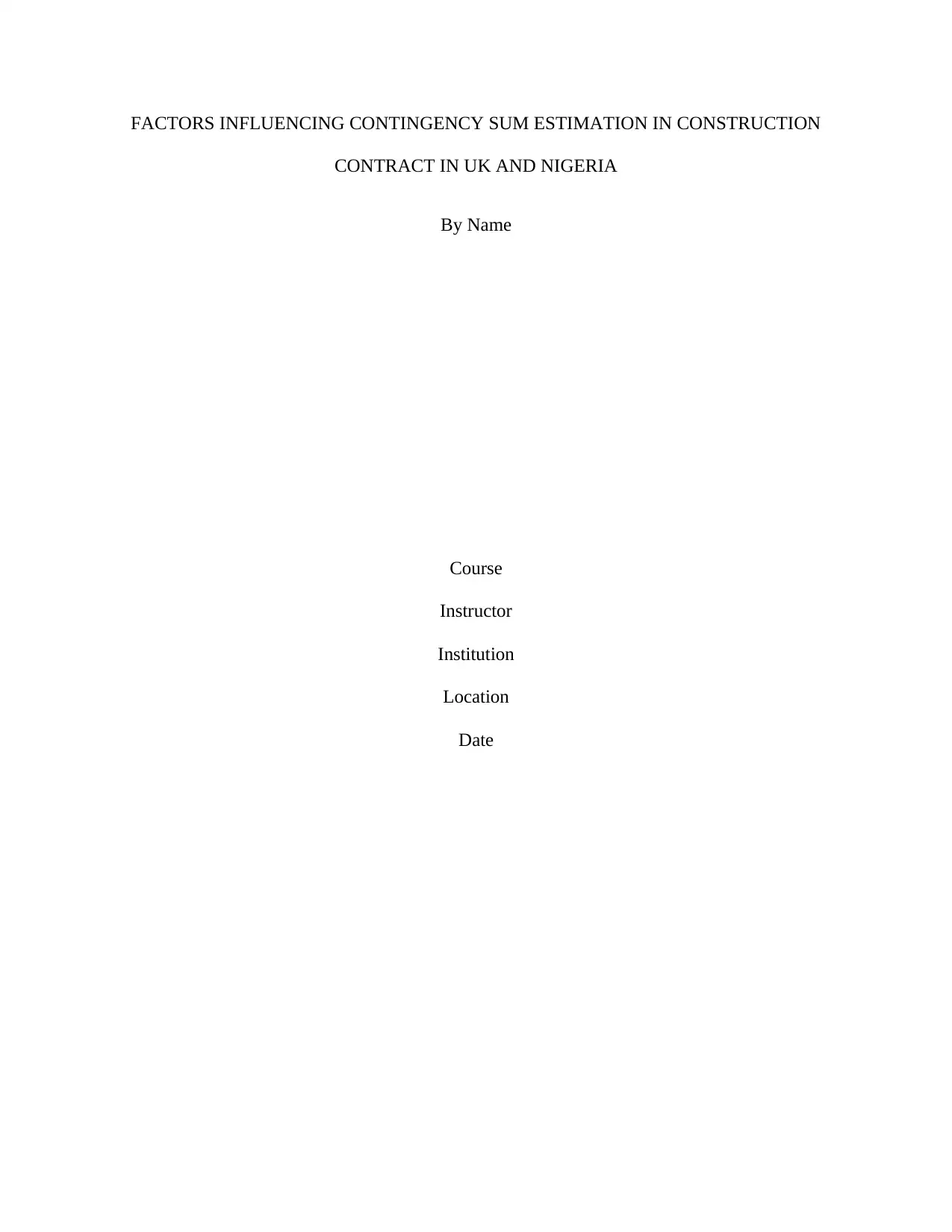
FACTORS INFLUENCING CONTINGENCY SUM ESTIMATION IN CONSTRUCTION
CONTRACT IN UK AND NIGERIA
By Name
Course
Instructor
Institution
Location
Date
CONTRACT IN UK AND NIGERIA
By Name
Course
Instructor
Institution
Location
Date
Paraphrase This Document
Need a fresh take? Get an instant paraphrase of this document with our AI Paraphraser
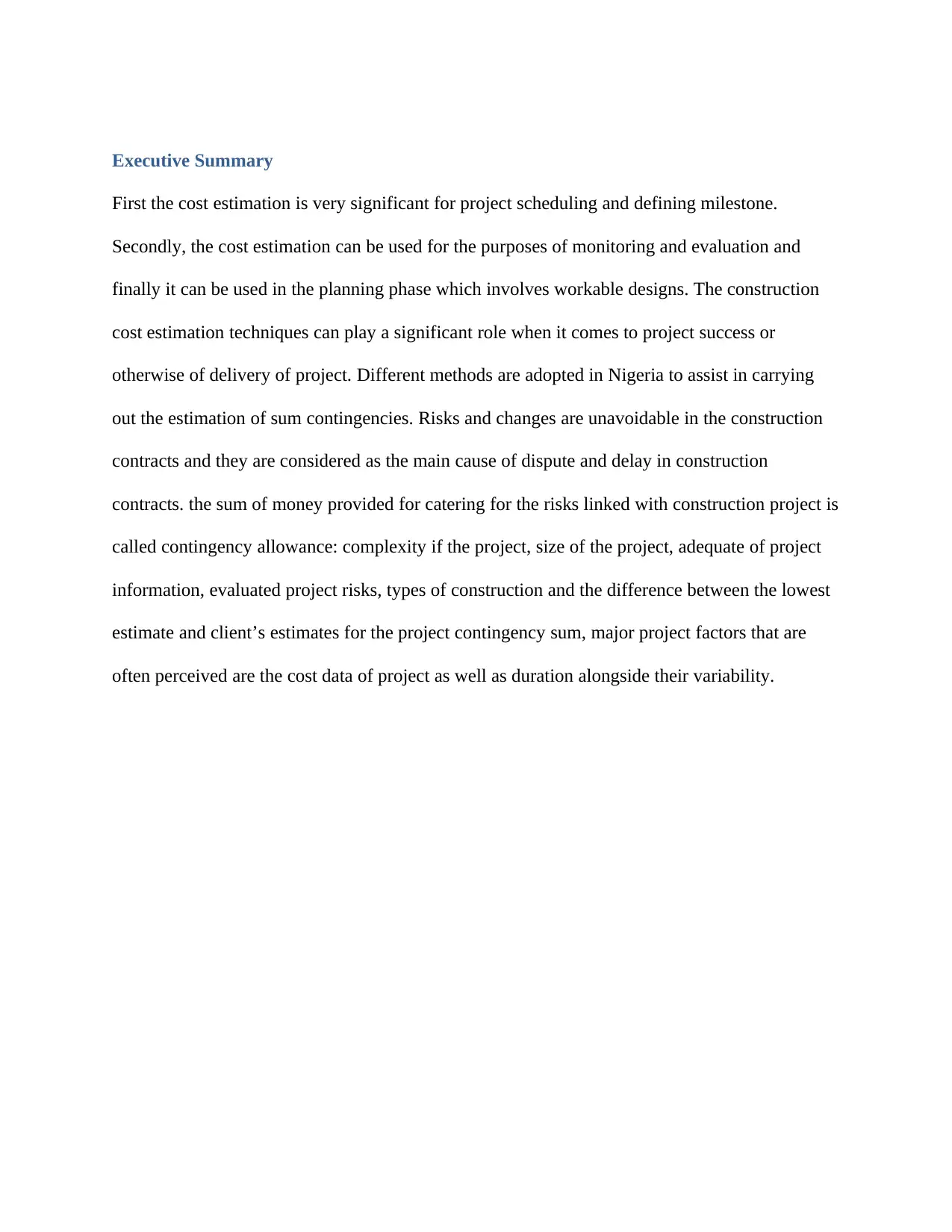
Executive Summary
First the cost estimation is very significant for project scheduling and defining milestone.
Secondly, the cost estimation can be used for the purposes of monitoring and evaluation and
finally it can be used in the planning phase which involves workable designs. The construction
cost estimation techniques can play a significant role when it comes to project success or
otherwise of delivery of project. Different methods are adopted in Nigeria to assist in carrying
out the estimation of sum contingencies. Risks and changes are unavoidable in the construction
contracts and they are considered as the main cause of dispute and delay in construction
contracts. the sum of money provided for catering for the risks linked with construction project is
called contingency allowance: complexity if the project, size of the project, adequate of project
information, evaluated project risks, types of construction and the difference between the lowest
estimate and client’s estimates for the project contingency sum, major project factors that are
often perceived are the cost data of project as well as duration alongside their variability.
First the cost estimation is very significant for project scheduling and defining milestone.
Secondly, the cost estimation can be used for the purposes of monitoring and evaluation and
finally it can be used in the planning phase which involves workable designs. The construction
cost estimation techniques can play a significant role when it comes to project success or
otherwise of delivery of project. Different methods are adopted in Nigeria to assist in carrying
out the estimation of sum contingencies. Risks and changes are unavoidable in the construction
contracts and they are considered as the main cause of dispute and delay in construction
contracts. the sum of money provided for catering for the risks linked with construction project is
called contingency allowance: complexity if the project, size of the project, adequate of project
information, evaluated project risks, types of construction and the difference between the lowest
estimate and client’s estimates for the project contingency sum, major project factors that are
often perceived are the cost data of project as well as duration alongside their variability.
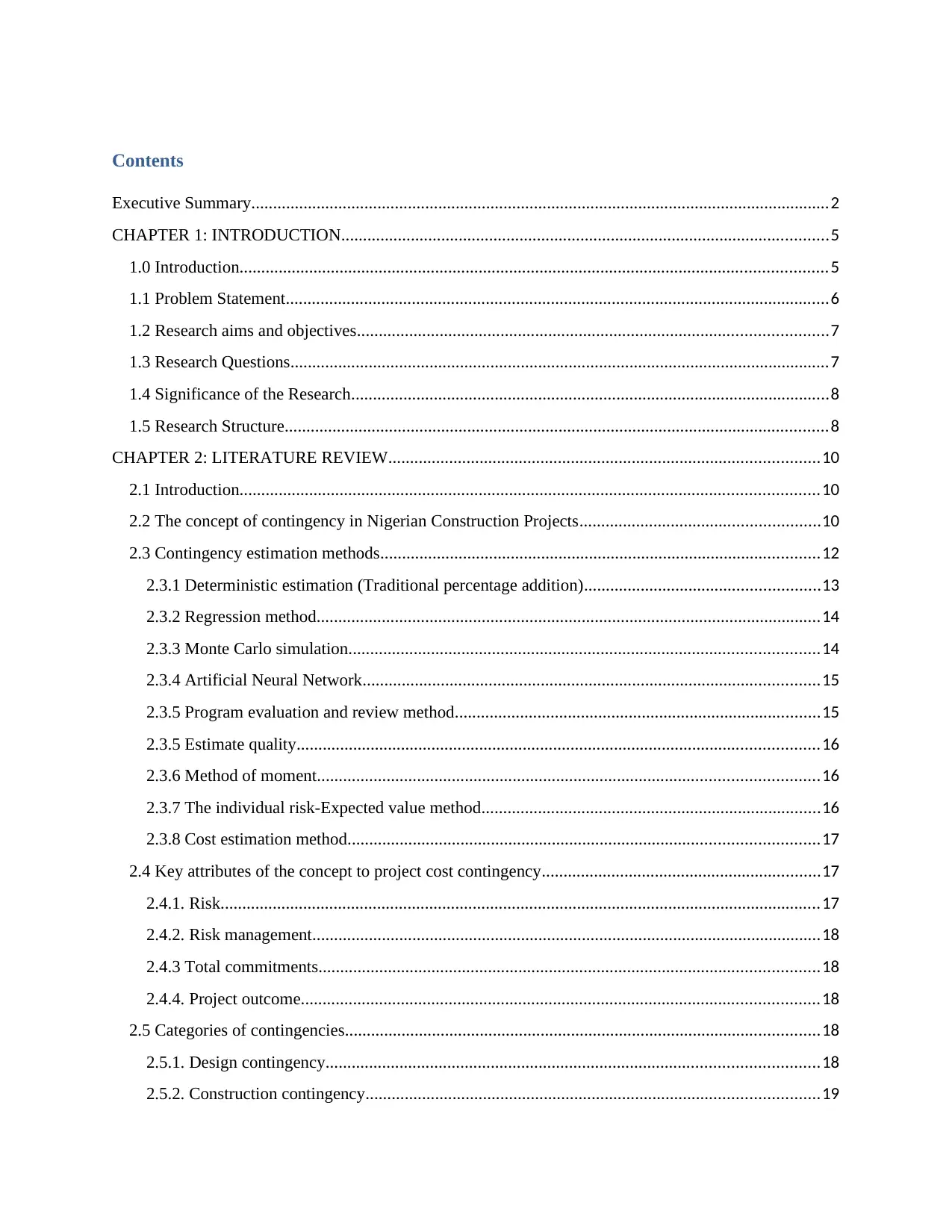
Contents
Executive Summary.....................................................................................................................................2
CHAPTER 1: INTRODUCTION................................................................................................................5
1.0 Introduction.......................................................................................................................................5
1.1 Problem Statement.............................................................................................................................6
1.2 Research aims and objectives............................................................................................................7
1.3 Research Questions............................................................................................................................7
1.4 Significance of the Research..............................................................................................................8
1.5 Research Structure.............................................................................................................................8
CHAPTER 2: LITERATURE REVIEW...................................................................................................10
2.1 Introduction.....................................................................................................................................10
2.2 The concept of contingency in Nigerian Construction Projects.......................................................10
2.3 Contingency estimation methods.....................................................................................................12
2.3.1 Deterministic estimation (Traditional percentage addition)......................................................13
2.3.2 Regression method....................................................................................................................14
2.3.3 Monte Carlo simulation............................................................................................................14
2.3.4 Artificial Neural Network.........................................................................................................15
2.3.5 Program evaluation and review method....................................................................................15
2.3.5 Estimate quality........................................................................................................................16
2.3.6 Method of moment...................................................................................................................16
2.3.7 The individual risk-Expected value method..............................................................................16
2.3.8 Cost estimation method............................................................................................................17
2.4 Key attributes of the concept to project cost contingency................................................................17
2.4.1. Risk..........................................................................................................................................17
2.4.2. Risk management.....................................................................................................................18
2.4.3 Total commitments...................................................................................................................18
2.4.4. Project outcome.......................................................................................................................18
2.5 Categories of contingencies.............................................................................................................18
2.5.1. Design contingency.................................................................................................................18
2.5.2. Construction contingency........................................................................................................19
Executive Summary.....................................................................................................................................2
CHAPTER 1: INTRODUCTION................................................................................................................5
1.0 Introduction.......................................................................................................................................5
1.1 Problem Statement.............................................................................................................................6
1.2 Research aims and objectives............................................................................................................7
1.3 Research Questions............................................................................................................................7
1.4 Significance of the Research..............................................................................................................8
1.5 Research Structure.............................................................................................................................8
CHAPTER 2: LITERATURE REVIEW...................................................................................................10
2.1 Introduction.....................................................................................................................................10
2.2 The concept of contingency in Nigerian Construction Projects.......................................................10
2.3 Contingency estimation methods.....................................................................................................12
2.3.1 Deterministic estimation (Traditional percentage addition)......................................................13
2.3.2 Regression method....................................................................................................................14
2.3.3 Monte Carlo simulation............................................................................................................14
2.3.4 Artificial Neural Network.........................................................................................................15
2.3.5 Program evaluation and review method....................................................................................15
2.3.5 Estimate quality........................................................................................................................16
2.3.6 Method of moment...................................................................................................................16
2.3.7 The individual risk-Expected value method..............................................................................16
2.3.8 Cost estimation method............................................................................................................17
2.4 Key attributes of the concept to project cost contingency................................................................17
2.4.1. Risk..........................................................................................................................................17
2.4.2. Risk management.....................................................................................................................18
2.4.3 Total commitments...................................................................................................................18
2.4.4. Project outcome.......................................................................................................................18
2.5 Categories of contingencies.............................................................................................................18
2.5.1. Design contingency.................................................................................................................18
2.5.2. Construction contingency........................................................................................................19
⊘ This is a preview!⊘
Do you want full access?
Subscribe today to unlock all pages.

Trusted by 1+ million students worldwide
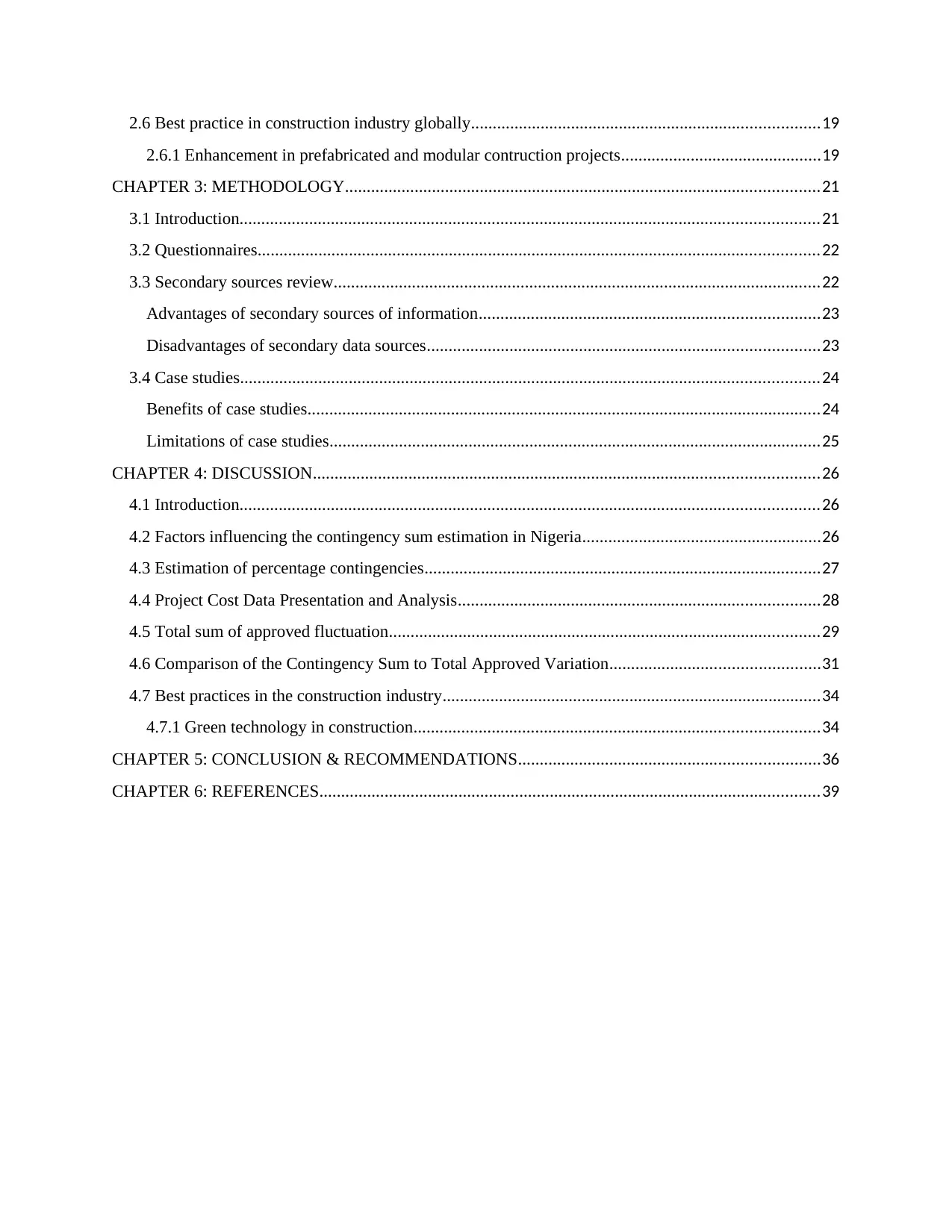
2.6 Best practice in construction industry globally................................................................................19
2.6.1 Enhancement in prefabricated and modular contruction projects..............................................19
CHAPTER 3: METHODOLOGY.............................................................................................................21
3.1 Introduction.....................................................................................................................................21
3.2 Questionnaires.................................................................................................................................22
3.3 Secondary sources review................................................................................................................22
Advantages of secondary sources of information..............................................................................23
Disadvantages of secondary data sources..........................................................................................23
3.4 Case studies.....................................................................................................................................24
Benefits of case studies......................................................................................................................24
Limitations of case studies.................................................................................................................25
CHAPTER 4: DISCUSSION....................................................................................................................26
4.1 Introduction.....................................................................................................................................26
4.2 Factors influencing the contingency sum estimation in Nigeria.......................................................26
4.3 Estimation of percentage contingencies...........................................................................................27
4.4 Project Cost Data Presentation and Analysis...................................................................................28
4.5 Total sum of approved fluctuation...................................................................................................29
4.6 Comparison of the Contingency Sum to Total Approved Variation................................................31
4.7 Best practices in the construction industry.......................................................................................34
4.7.1 Green technology in construction.............................................................................................34
CHAPTER 5: CONCLUSION & RECOMMENDATIONS.....................................................................36
CHAPTER 6: REFERENCES...................................................................................................................39
2.6.1 Enhancement in prefabricated and modular contruction projects..............................................19
CHAPTER 3: METHODOLOGY.............................................................................................................21
3.1 Introduction.....................................................................................................................................21
3.2 Questionnaires.................................................................................................................................22
3.3 Secondary sources review................................................................................................................22
Advantages of secondary sources of information..............................................................................23
Disadvantages of secondary data sources..........................................................................................23
3.4 Case studies.....................................................................................................................................24
Benefits of case studies......................................................................................................................24
Limitations of case studies.................................................................................................................25
CHAPTER 4: DISCUSSION....................................................................................................................26
4.1 Introduction.....................................................................................................................................26
4.2 Factors influencing the contingency sum estimation in Nigeria.......................................................26
4.3 Estimation of percentage contingencies...........................................................................................27
4.4 Project Cost Data Presentation and Analysis...................................................................................28
4.5 Total sum of approved fluctuation...................................................................................................29
4.6 Comparison of the Contingency Sum to Total Approved Variation................................................31
4.7 Best practices in the construction industry.......................................................................................34
4.7.1 Green technology in construction.............................................................................................34
CHAPTER 5: CONCLUSION & RECOMMENDATIONS.....................................................................36
CHAPTER 6: REFERENCES...................................................................................................................39
Paraphrase This Document
Need a fresh take? Get an instant paraphrase of this document with our AI Paraphraser
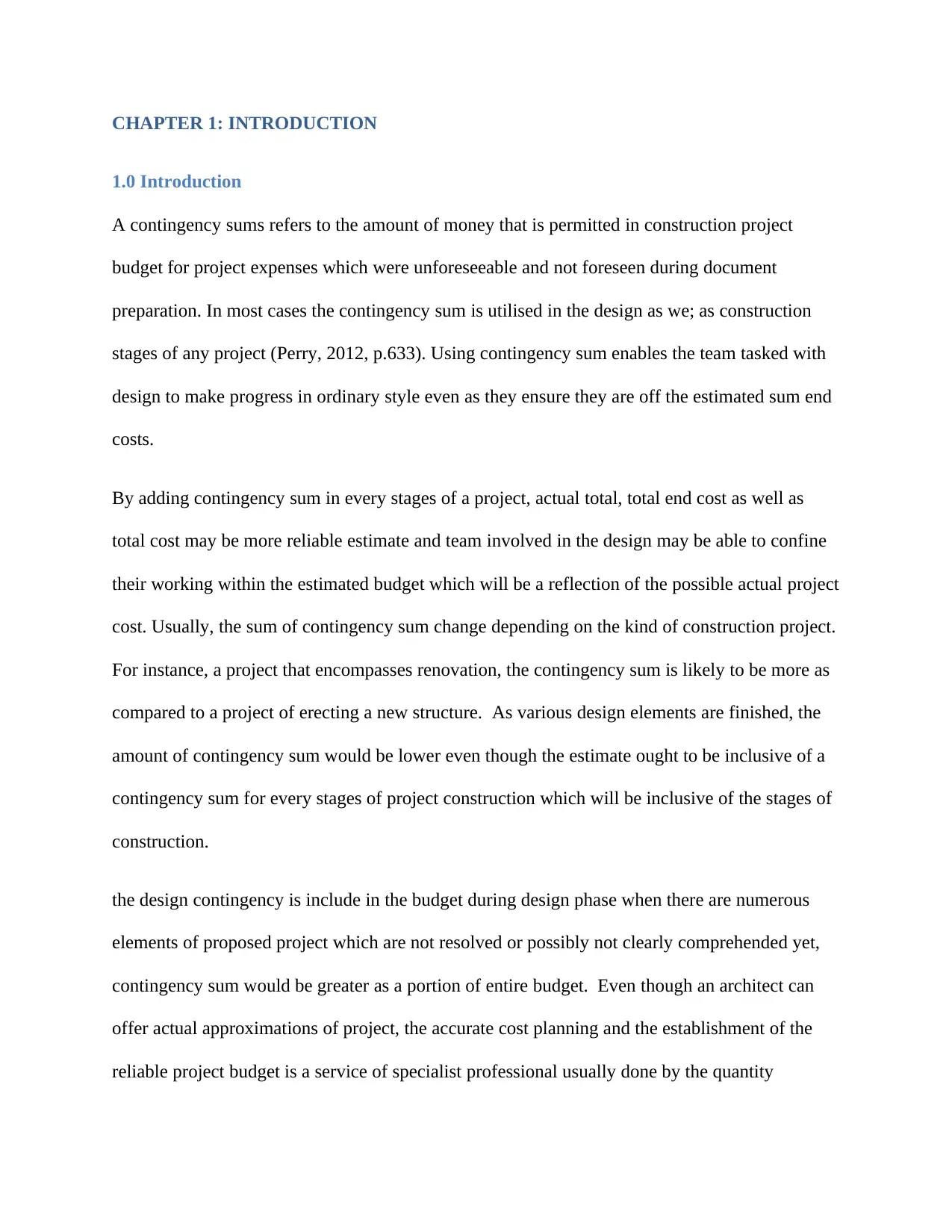
CHAPTER 1: INTRODUCTION
1.0 Introduction
A contingency sums refers to the amount of money that is permitted in construction project
budget for project expenses which were unforeseeable and not foreseen during document
preparation. In most cases the contingency sum is utilised in the design as we; as construction
stages of any project (Perry, 2012, p.633). Using contingency sum enables the team tasked with
design to make progress in ordinary style even as they ensure they are off the estimated sum end
costs.
By adding contingency sum in every stages of a project, actual total, total end cost as well as
total cost may be more reliable estimate and team involved in the design may be able to confine
their working within the estimated budget which will be a reflection of the possible actual project
cost. Usually, the sum of contingency sum change depending on the kind of construction project.
For instance, a project that encompasses renovation, the contingency sum is likely to be more as
compared to a project of erecting a new structure. As various design elements are finished, the
amount of contingency sum would be lower even though the estimate ought to be inclusive of a
contingency sum for every stages of project construction which will be inclusive of the stages of
construction.
the design contingency is include in the budget during design phase when there are numerous
elements of proposed project which are not resolved or possibly not clearly comprehended yet,
contingency sum would be greater as a portion of entire budget. Even though an architect can
offer actual approximations of project, the accurate cost planning and the establishment of the
reliable project budget is a service of specialist professional usually done by the quantity
1.0 Introduction
A contingency sums refers to the amount of money that is permitted in construction project
budget for project expenses which were unforeseeable and not foreseen during document
preparation. In most cases the contingency sum is utilised in the design as we; as construction
stages of any project (Perry, 2012, p.633). Using contingency sum enables the team tasked with
design to make progress in ordinary style even as they ensure they are off the estimated sum end
costs.
By adding contingency sum in every stages of a project, actual total, total end cost as well as
total cost may be more reliable estimate and team involved in the design may be able to confine
their working within the estimated budget which will be a reflection of the possible actual project
cost. Usually, the sum of contingency sum change depending on the kind of construction project.
For instance, a project that encompasses renovation, the contingency sum is likely to be more as
compared to a project of erecting a new structure. As various design elements are finished, the
amount of contingency sum would be lower even though the estimate ought to be inclusive of a
contingency sum for every stages of project construction which will be inclusive of the stages of
construction.
the design contingency is include in the budget during design phase when there are numerous
elements of proposed project which are not resolved or possibly not clearly comprehended yet,
contingency sum would be greater as a portion of entire budget. Even though an architect can
offer actual approximations of project, the accurate cost planning and the establishment of the
reliable project budget is a service of specialist professional usually done by the quantity
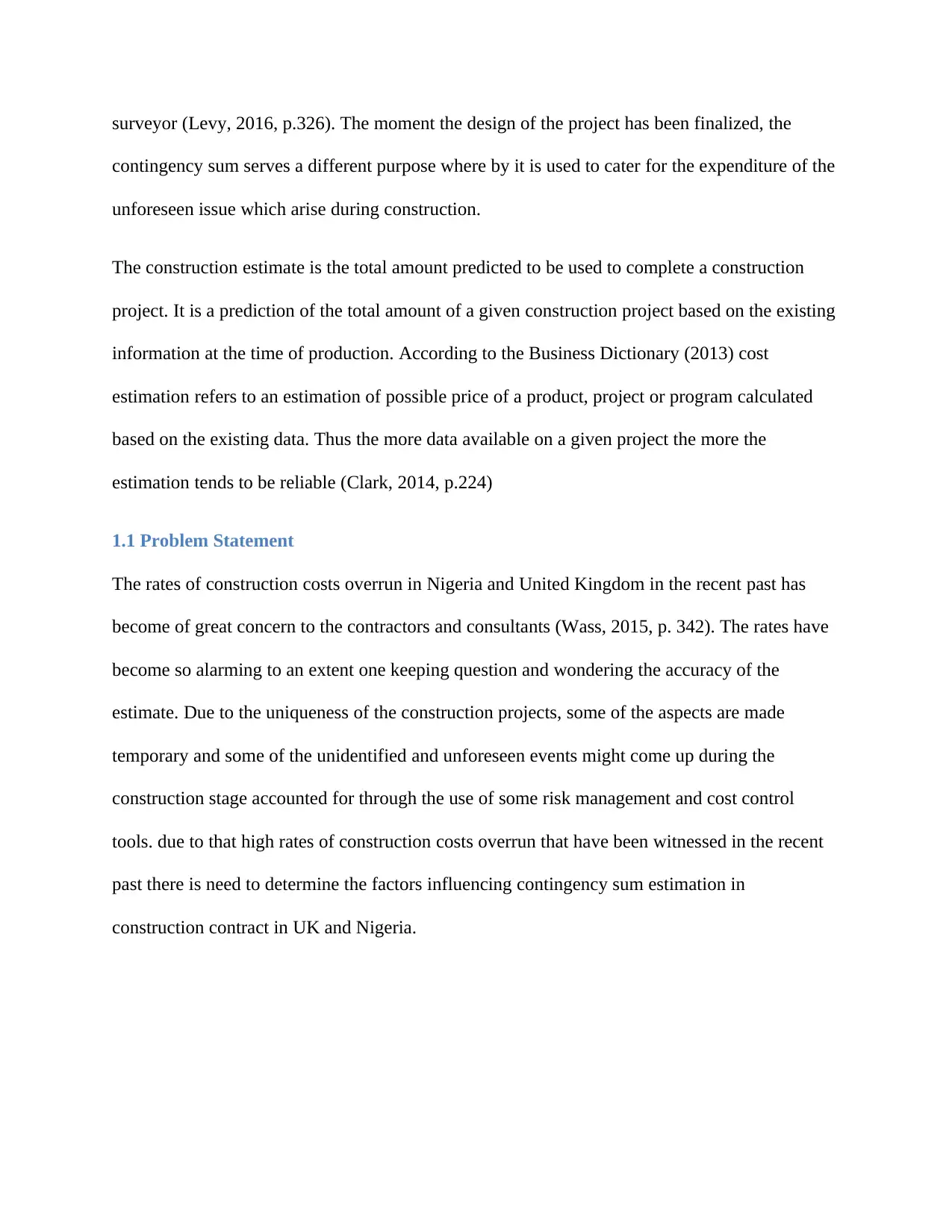
surveyor (Levy, 2016, p.326). The moment the design of the project has been finalized, the
contingency sum serves a different purpose where by it is used to cater for the expenditure of the
unforeseen issue which arise during construction.
The construction estimate is the total amount predicted to be used to complete a construction
project. It is a prediction of the total amount of a given construction project based on the existing
information at the time of production. According to the Business Dictionary (2013) cost
estimation refers to an estimation of possible price of a product, project or program calculated
based on the existing data. Thus the more data available on a given project the more the
estimation tends to be reliable (Clark, 2014, p.224)
1.1 Problem Statement
The rates of construction costs overrun in Nigeria and United Kingdom in the recent past has
become of great concern to the contractors and consultants (Wass, 2015, p. 342). The rates have
become so alarming to an extent one keeping question and wondering the accuracy of the
estimate. Due to the uniqueness of the construction projects, some of the aspects are made
temporary and some of the unidentified and unforeseen events might come up during the
construction stage accounted for through the use of some risk management and cost control
tools. due to that high rates of construction costs overrun that have been witnessed in the recent
past there is need to determine the factors influencing contingency sum estimation in
construction contract in UK and Nigeria.
contingency sum serves a different purpose where by it is used to cater for the expenditure of the
unforeseen issue which arise during construction.
The construction estimate is the total amount predicted to be used to complete a construction
project. It is a prediction of the total amount of a given construction project based on the existing
information at the time of production. According to the Business Dictionary (2013) cost
estimation refers to an estimation of possible price of a product, project or program calculated
based on the existing data. Thus the more data available on a given project the more the
estimation tends to be reliable (Clark, 2014, p.224)
1.1 Problem Statement
The rates of construction costs overrun in Nigeria and United Kingdom in the recent past has
become of great concern to the contractors and consultants (Wass, 2015, p. 342). The rates have
become so alarming to an extent one keeping question and wondering the accuracy of the
estimate. Due to the uniqueness of the construction projects, some of the aspects are made
temporary and some of the unidentified and unforeseen events might come up during the
construction stage accounted for through the use of some risk management and cost control
tools. due to that high rates of construction costs overrun that have been witnessed in the recent
past there is need to determine the factors influencing contingency sum estimation in
construction contract in UK and Nigeria.
⊘ This is a preview!⊘
Do you want full access?
Subscribe today to unlock all pages.

Trusted by 1+ million students worldwide
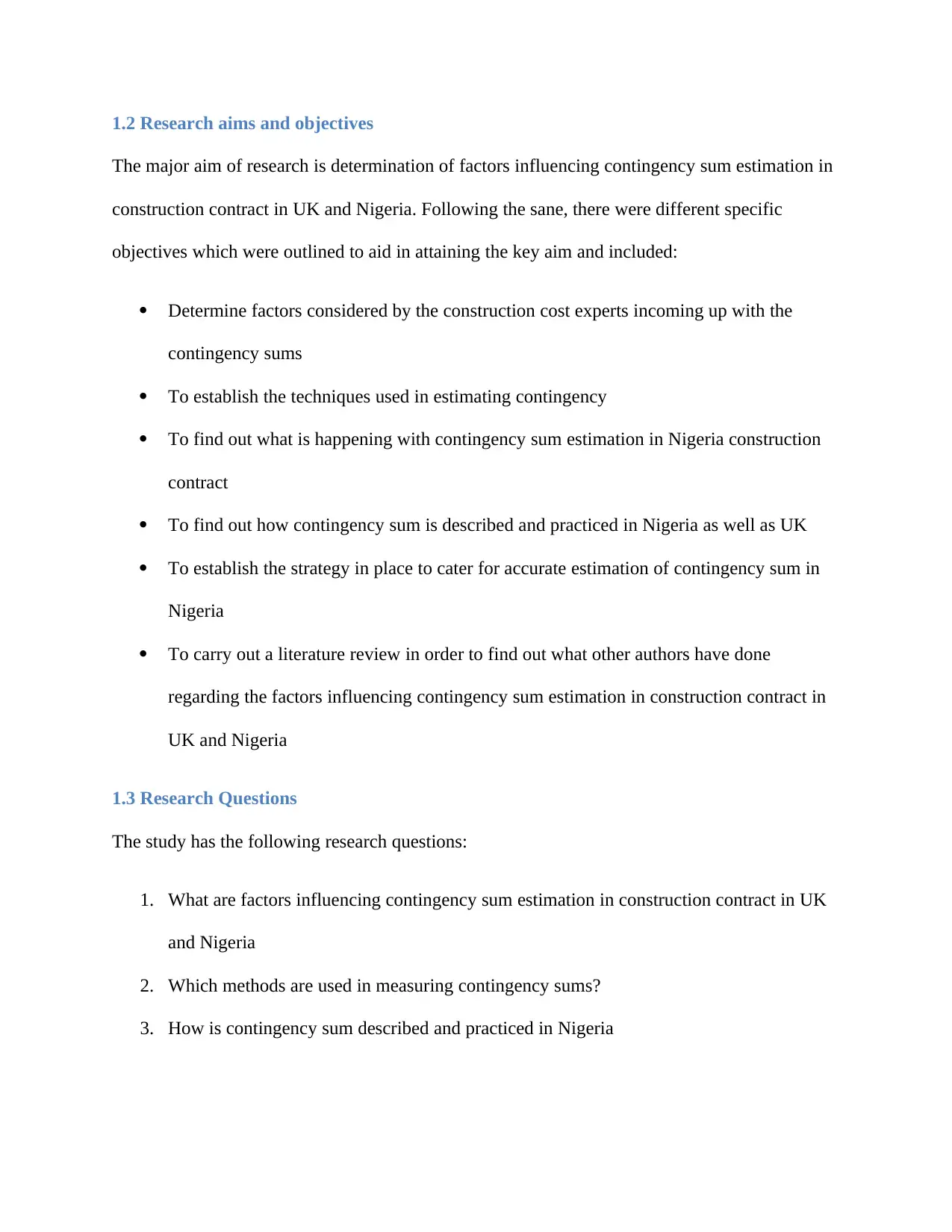
1.2 Research aims and objectives
The major aim of research is determination of factors influencing contingency sum estimation in
construction contract in UK and Nigeria. Following the sane, there were different specific
objectives which were outlined to aid in attaining the key aim and included:
Determine factors considered by the construction cost experts incoming up with the
contingency sums
To establish the techniques used in estimating contingency
To find out what is happening with contingency sum estimation in Nigeria construction
contract
To find out how contingency sum is described and practiced in Nigeria as well as UK
To establish the strategy in place to cater for accurate estimation of contingency sum in
Nigeria
To carry out a literature review in order to find out what other authors have done
regarding the factors influencing contingency sum estimation in construction contract in
UK and Nigeria
1.3 Research Questions
The study has the following research questions:
1. What are factors influencing contingency sum estimation in construction contract in UK
and Nigeria
2. Which methods are used in measuring contingency sums?
3. How is contingency sum described and practiced in Nigeria
The major aim of research is determination of factors influencing contingency sum estimation in
construction contract in UK and Nigeria. Following the sane, there were different specific
objectives which were outlined to aid in attaining the key aim and included:
Determine factors considered by the construction cost experts incoming up with the
contingency sums
To establish the techniques used in estimating contingency
To find out what is happening with contingency sum estimation in Nigeria construction
contract
To find out how contingency sum is described and practiced in Nigeria as well as UK
To establish the strategy in place to cater for accurate estimation of contingency sum in
Nigeria
To carry out a literature review in order to find out what other authors have done
regarding the factors influencing contingency sum estimation in construction contract in
UK and Nigeria
1.3 Research Questions
The study has the following research questions:
1. What are factors influencing contingency sum estimation in construction contract in UK
and Nigeria
2. Which methods are used in measuring contingency sums?
3. How is contingency sum described and practiced in Nigeria
Paraphrase This Document
Need a fresh take? Get an instant paraphrase of this document with our AI Paraphraser
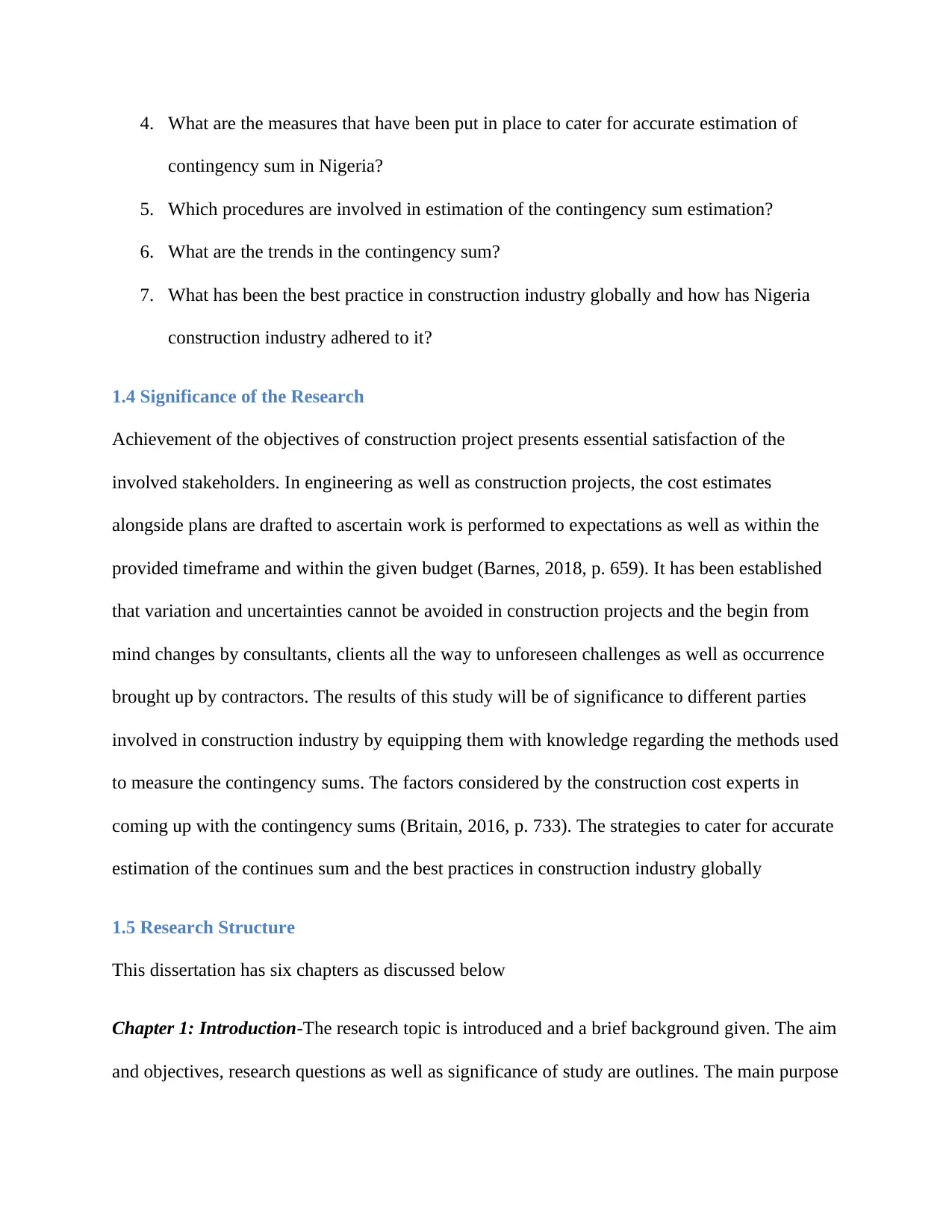
4. What are the measures that have been put in place to cater for accurate estimation of
contingency sum in Nigeria?
5. Which procedures are involved in estimation of the contingency sum estimation?
6. What are the trends in the contingency sum?
7. What has been the best practice in construction industry globally and how has Nigeria
construction industry adhered to it?
1.4 Significance of the Research
Achievement of the objectives of construction project presents essential satisfaction of the
involved stakeholders. In engineering as well as construction projects, the cost estimates
alongside plans are drafted to ascertain work is performed to expectations as well as within the
provided timeframe and within the given budget (Barnes, 2018, p. 659). It has been established
that variation and uncertainties cannot be avoided in construction projects and the begin from
mind changes by consultants, clients all the way to unforeseen challenges as well as occurrence
brought up by contractors. The results of this study will be of significance to different parties
involved in construction industry by equipping them with knowledge regarding the methods used
to measure the contingency sums. The factors considered by the construction cost experts in
coming up with the contingency sums (Britain, 2016, p. 733). The strategies to cater for accurate
estimation of the continues sum and the best practices in construction industry globally
1.5 Research Structure
This dissertation has six chapters as discussed below
Chapter 1: Introduction-The research topic is introduced and a brief background given. The aim
and objectives, research questions as well as significance of study are outlines. The main purpose
contingency sum in Nigeria?
5. Which procedures are involved in estimation of the contingency sum estimation?
6. What are the trends in the contingency sum?
7. What has been the best practice in construction industry globally and how has Nigeria
construction industry adhered to it?
1.4 Significance of the Research
Achievement of the objectives of construction project presents essential satisfaction of the
involved stakeholders. In engineering as well as construction projects, the cost estimates
alongside plans are drafted to ascertain work is performed to expectations as well as within the
provided timeframe and within the given budget (Barnes, 2018, p. 659). It has been established
that variation and uncertainties cannot be avoided in construction projects and the begin from
mind changes by consultants, clients all the way to unforeseen challenges as well as occurrence
brought up by contractors. The results of this study will be of significance to different parties
involved in construction industry by equipping them with knowledge regarding the methods used
to measure the contingency sums. The factors considered by the construction cost experts in
coming up with the contingency sums (Britain, 2016, p. 733). The strategies to cater for accurate
estimation of the continues sum and the best practices in construction industry globally
1.5 Research Structure
This dissertation has six chapters as discussed below
Chapter 1: Introduction-The research topic is introduced and a brief background given. The aim
and objectives, research questions as well as significance of study are outlines. The main purpose
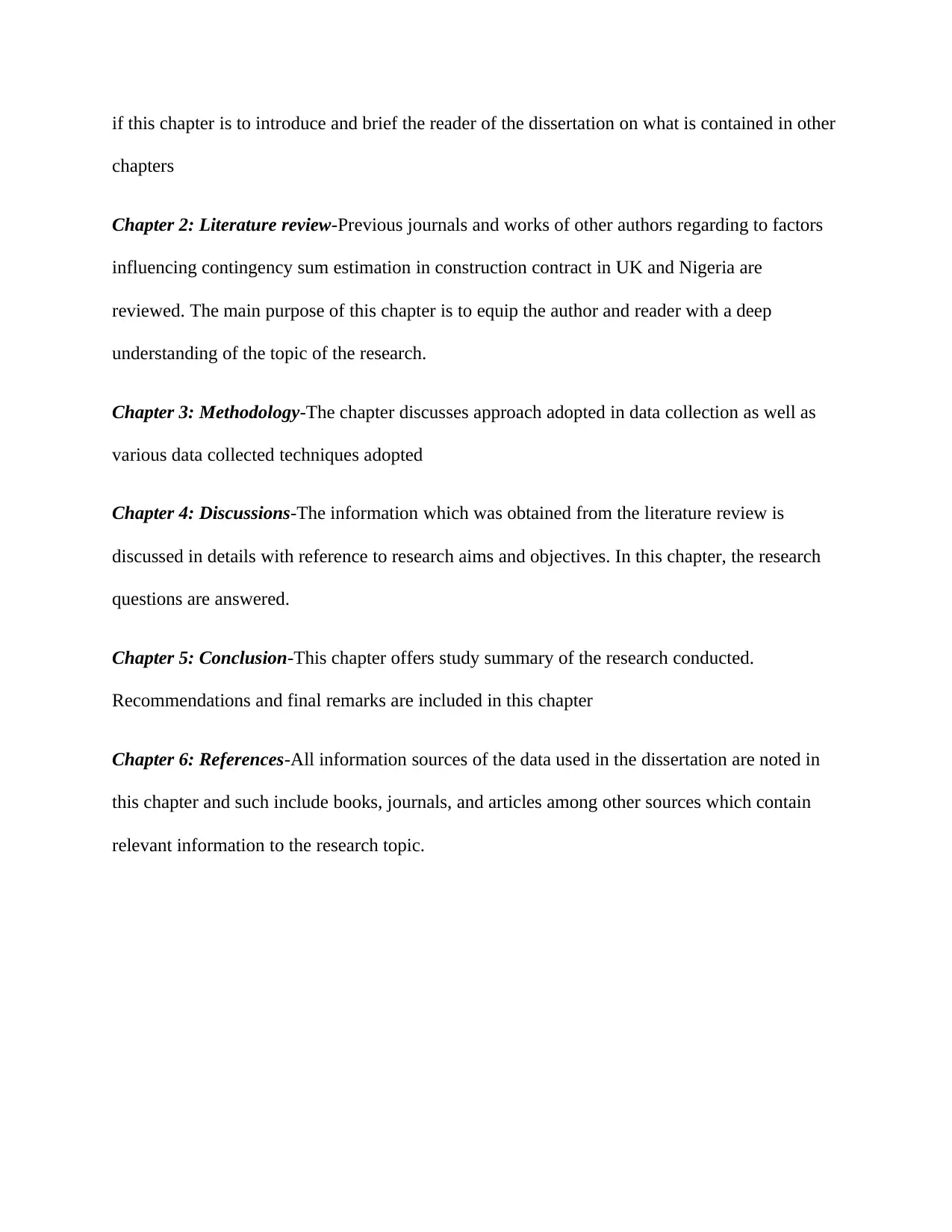
if this chapter is to introduce and brief the reader of the dissertation on what is contained in other
chapters
Chapter 2: Literature review-Previous journals and works of other authors regarding to factors
influencing contingency sum estimation in construction contract in UK and Nigeria are
reviewed. The main purpose of this chapter is to equip the author and reader with a deep
understanding of the topic of the research.
Chapter 3: Methodology-The chapter discusses approach adopted in data collection as well as
various data collected techniques adopted
Chapter 4: Discussions-The information which was obtained from the literature review is
discussed in details with reference to research aims and objectives. In this chapter, the research
questions are answered.
Chapter 5: Conclusion-This chapter offers study summary of the research conducted.
Recommendations and final remarks are included in this chapter
Chapter 6: References-All information sources of the data used in the dissertation are noted in
this chapter and such include books, journals, and articles among other sources which contain
relevant information to the research topic.
chapters
Chapter 2: Literature review-Previous journals and works of other authors regarding to factors
influencing contingency sum estimation in construction contract in UK and Nigeria are
reviewed. The main purpose of this chapter is to equip the author and reader with a deep
understanding of the topic of the research.
Chapter 3: Methodology-The chapter discusses approach adopted in data collection as well as
various data collected techniques adopted
Chapter 4: Discussions-The information which was obtained from the literature review is
discussed in details with reference to research aims and objectives. In this chapter, the research
questions are answered.
Chapter 5: Conclusion-This chapter offers study summary of the research conducted.
Recommendations and final remarks are included in this chapter
Chapter 6: References-All information sources of the data used in the dissertation are noted in
this chapter and such include books, journals, and articles among other sources which contain
relevant information to the research topic.
⊘ This is a preview!⊘
Do you want full access?
Subscribe today to unlock all pages.

Trusted by 1+ million students worldwide
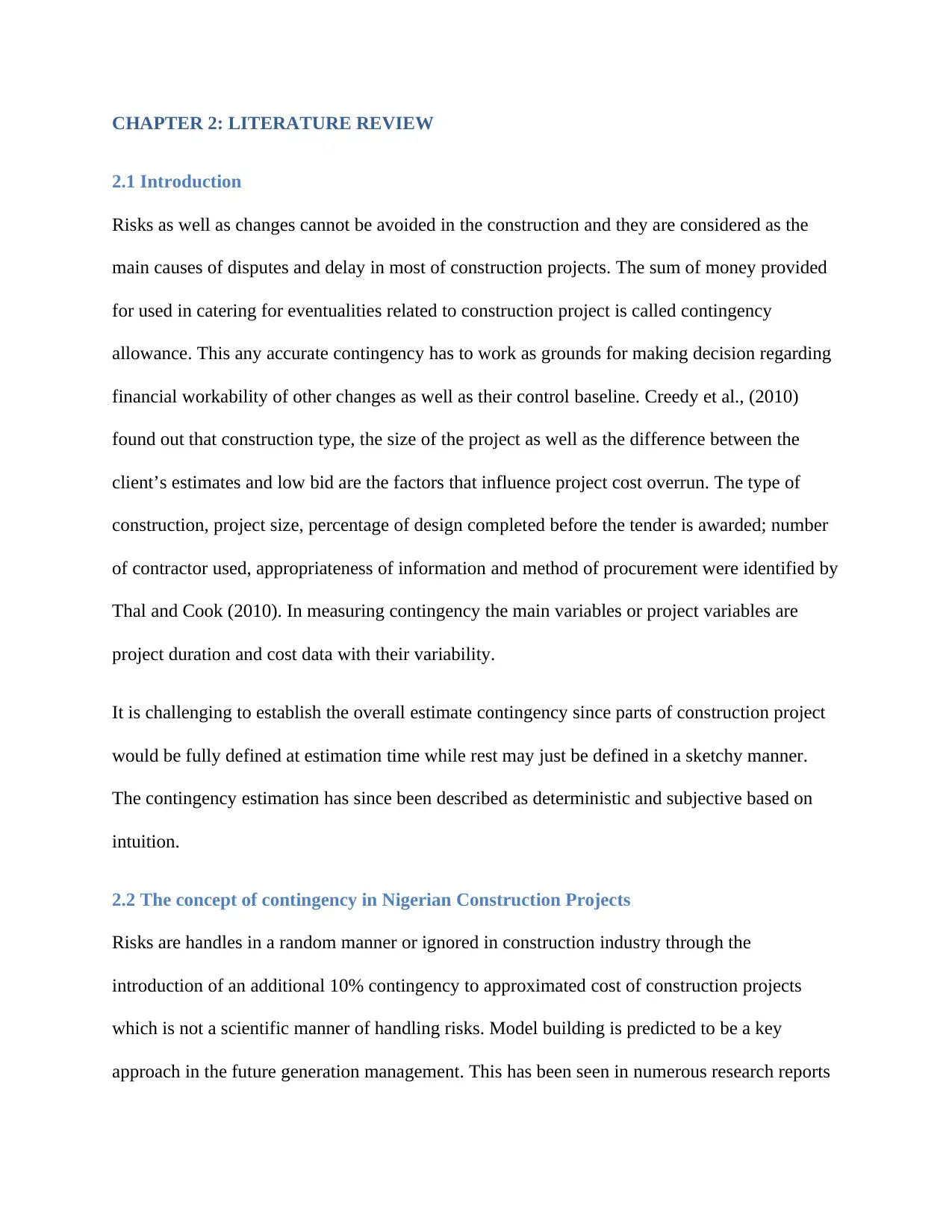
CHAPTER 2: LITERATURE REVIEW
2.1 Introduction
Risks as well as changes cannot be avoided in the construction and they are considered as the
main causes of disputes and delay in most of construction projects. The sum of money provided
for used in catering for eventualities related to construction project is called contingency
allowance. This any accurate contingency has to work as grounds for making decision regarding
financial workability of other changes as well as their control baseline. Creedy et al., (2010)
found out that construction type, the size of the project as well as the difference between the
client’s estimates and low bid are the factors that influence project cost overrun. The type of
construction, project size, percentage of design completed before the tender is awarded; number
of contractor used, appropriateness of information and method of procurement were identified by
Thal and Cook (2010). In measuring contingency the main variables or project variables are
project duration and cost data with their variability.
It is challenging to establish the overall estimate contingency since parts of construction project
would be fully defined at estimation time while rest may just be defined in a sketchy manner.
The contingency estimation has since been described as deterministic and subjective based on
intuition.
2.2 The concept of contingency in Nigerian Construction Projects
Risks are handles in a random manner or ignored in construction industry through the
introduction of an additional 10% contingency to approximated cost of construction projects
which is not a scientific manner of handling risks. Model building is predicted to be a key
approach in the future generation management. This has been seen in numerous research reports
2.1 Introduction
Risks as well as changes cannot be avoided in the construction and they are considered as the
main causes of disputes and delay in most of construction projects. The sum of money provided
for used in catering for eventualities related to construction project is called contingency
allowance. This any accurate contingency has to work as grounds for making decision regarding
financial workability of other changes as well as their control baseline. Creedy et al., (2010)
found out that construction type, the size of the project as well as the difference between the
client’s estimates and low bid are the factors that influence project cost overrun. The type of
construction, project size, percentage of design completed before the tender is awarded; number
of contractor used, appropriateness of information and method of procurement were identified by
Thal and Cook (2010). In measuring contingency the main variables or project variables are
project duration and cost data with their variability.
It is challenging to establish the overall estimate contingency since parts of construction project
would be fully defined at estimation time while rest may just be defined in a sketchy manner.
The contingency estimation has since been described as deterministic and subjective based on
intuition.
2.2 The concept of contingency in Nigerian Construction Projects
Risks are handles in a random manner or ignored in construction industry through the
introduction of an additional 10% contingency to approximated cost of construction projects
which is not a scientific manner of handling risks. Model building is predicted to be a key
approach in the future generation management. This has been seen in numerous research reports
Paraphrase This Document
Need a fresh take? Get an instant paraphrase of this document with our AI Paraphraser
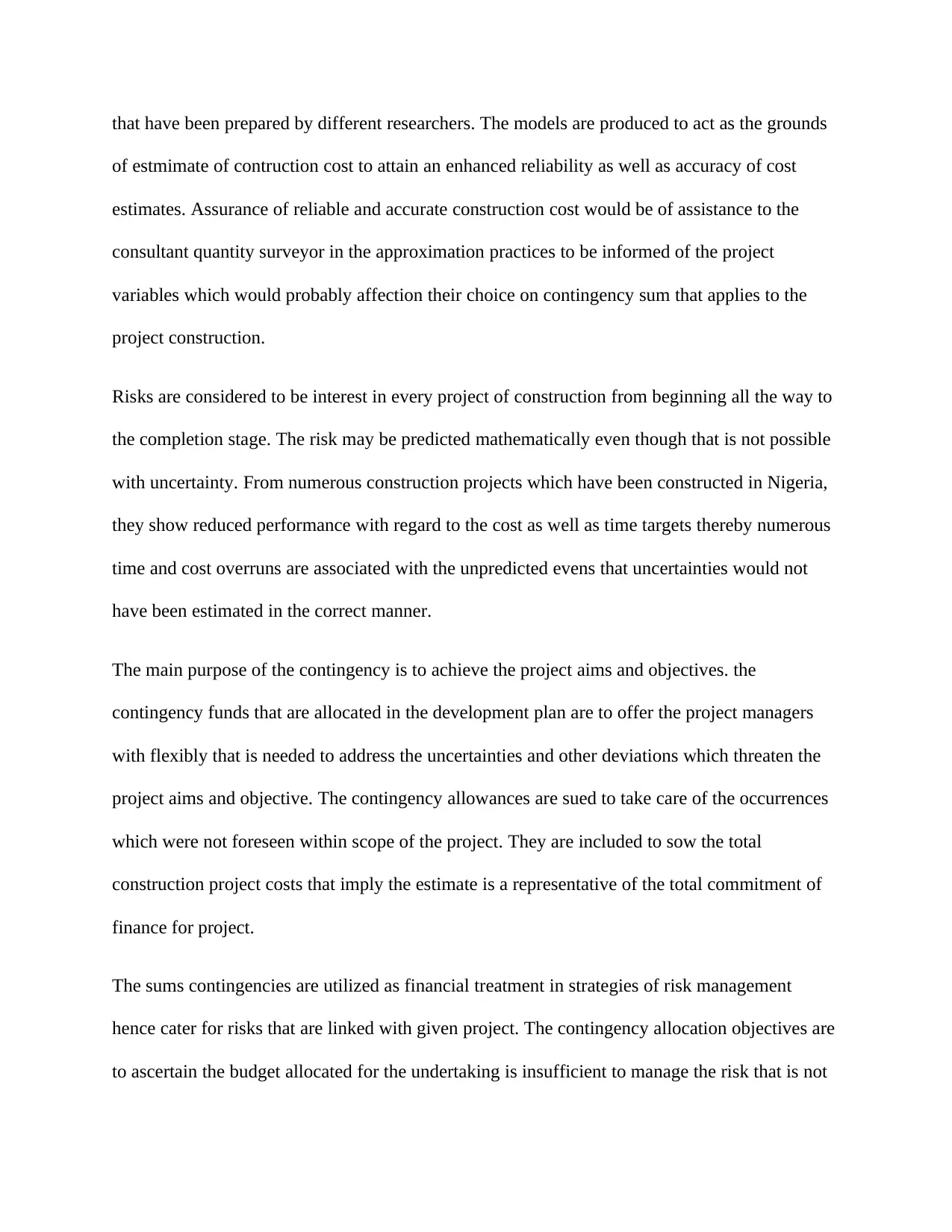
that have been prepared by different researchers. The models are produced to act as the grounds
of estmimate of contruction cost to attain an enhanced reliability as well as accuracy of cost
estimates. Assurance of reliable and accurate construction cost would be of assistance to the
consultant quantity surveyor in the approximation practices to be informed of the project
variables which would probably affection their choice on contingency sum that applies to the
project construction.
Risks are considered to be interest in every project of construction from beginning all the way to
the completion stage. The risk may be predicted mathematically even though that is not possible
with uncertainty. From numerous construction projects which have been constructed in Nigeria,
they show reduced performance with regard to the cost as well as time targets thereby numerous
time and cost overruns are associated with the unpredicted evens that uncertainties would not
have been estimated in the correct manner.
The main purpose of the contingency is to achieve the project aims and objectives. the
contingency funds that are allocated in the development plan are to offer the project managers
with flexibly that is needed to address the uncertainties and other deviations which threaten the
project aims and objective. The contingency allowances are sued to take care of the occurrences
which were not foreseen within scope of the project. They are included to sow the total
construction project costs that imply the estimate is a representative of the total commitment of
finance for project.
The sums contingencies are utilized as financial treatment in strategies of risk management
hence cater for risks that are linked with given project. The contingency allocation objectives are
to ascertain the budget allocated for the undertaking is insufficient to manage the risk that is not
of estmimate of contruction cost to attain an enhanced reliability as well as accuracy of cost
estimates. Assurance of reliable and accurate construction cost would be of assistance to the
consultant quantity surveyor in the approximation practices to be informed of the project
variables which would probably affection their choice on contingency sum that applies to the
project construction.
Risks are considered to be interest in every project of construction from beginning all the way to
the completion stage. The risk may be predicted mathematically even though that is not possible
with uncertainty. From numerous construction projects which have been constructed in Nigeria,
they show reduced performance with regard to the cost as well as time targets thereby numerous
time and cost overruns are associated with the unpredicted evens that uncertainties would not
have been estimated in the correct manner.
The main purpose of the contingency is to achieve the project aims and objectives. the
contingency funds that are allocated in the development plan are to offer the project managers
with flexibly that is needed to address the uncertainties and other deviations which threaten the
project aims and objective. The contingency allowances are sued to take care of the occurrences
which were not foreseen within scope of the project. They are included to sow the total
construction project costs that imply the estimate is a representative of the total commitment of
finance for project.
The sums contingencies are utilized as financial treatment in strategies of risk management
hence cater for risks that are linked with given project. The contingency allocation objectives are
to ascertain the budget allocated for the undertaking is insufficient to manage the risk that is not
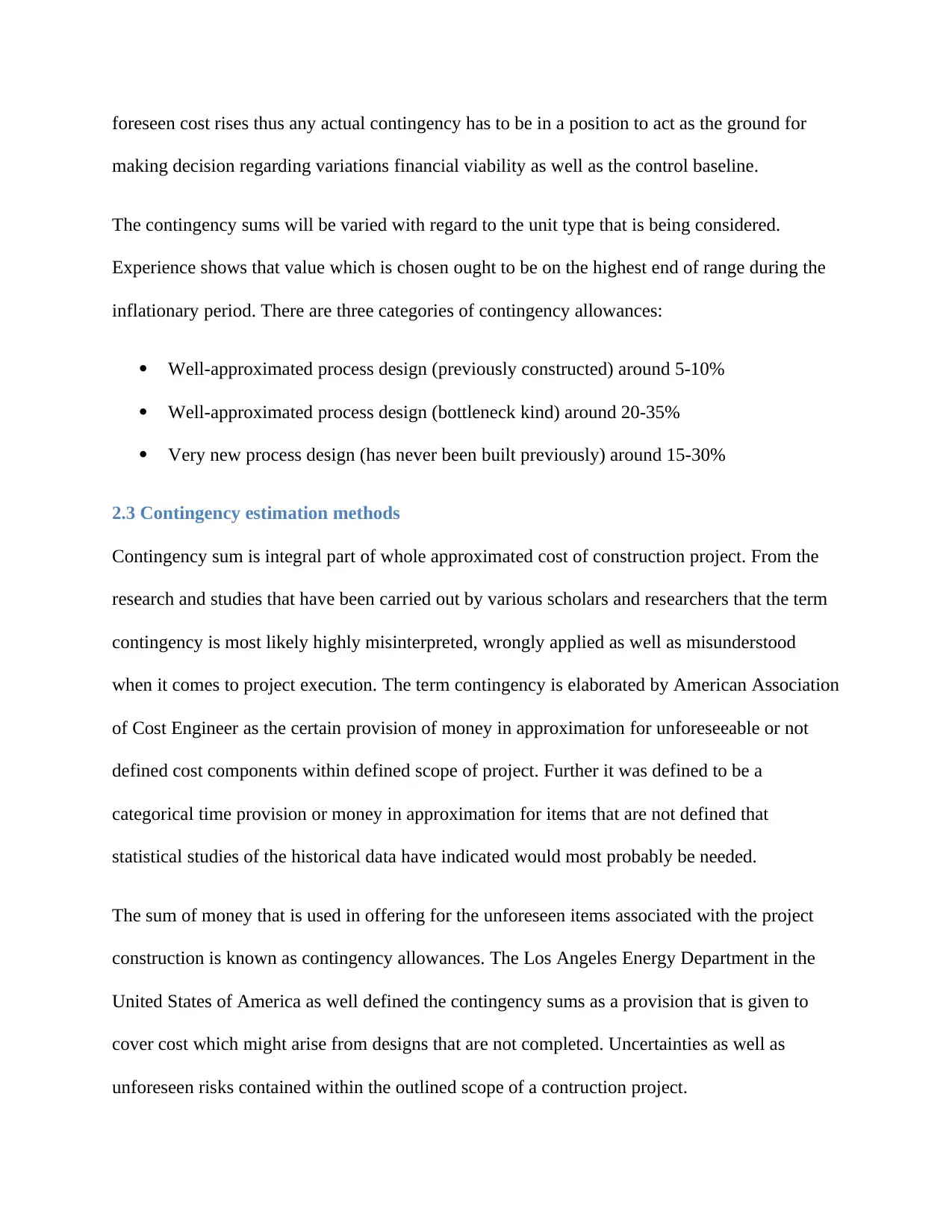
foreseen cost rises thus any actual contingency has to be in a position to act as the ground for
making decision regarding variations financial viability as well as the control baseline.
The contingency sums will be varied with regard to the unit type that is being considered.
Experience shows that value which is chosen ought to be on the highest end of range during the
inflationary period. There are three categories of contingency allowances:
Well-approximated process design (previously constructed) around 5-10%
Well-approximated process design (bottleneck kind) around 20-35%
Very new process design (has never been built previously) around 15-30%
2.3 Contingency estimation methods
Contingency sum is integral part of whole approximated cost of construction project. From the
research and studies that have been carried out by various scholars and researchers that the term
contingency is most likely highly misinterpreted, wrongly applied as well as misunderstood
when it comes to project execution. The term contingency is elaborated by American Association
of Cost Engineer as the certain provision of money in approximation for unforeseeable or not
defined cost components within defined scope of project. Further it was defined to be a
categorical time provision or money in approximation for items that are not defined that
statistical studies of the historical data have indicated would most probably be needed.
The sum of money that is used in offering for the unforeseen items associated with the project
construction is known as contingency allowances. The Los Angeles Energy Department in the
United States of America as well defined the contingency sums as a provision that is given to
cover cost which might arise from designs that are not completed. Uncertainties as well as
unforeseen risks contained within the outlined scope of a contruction project.
making decision regarding variations financial viability as well as the control baseline.
The contingency sums will be varied with regard to the unit type that is being considered.
Experience shows that value which is chosen ought to be on the highest end of range during the
inflationary period. There are three categories of contingency allowances:
Well-approximated process design (previously constructed) around 5-10%
Well-approximated process design (bottleneck kind) around 20-35%
Very new process design (has never been built previously) around 15-30%
2.3 Contingency estimation methods
Contingency sum is integral part of whole approximated cost of construction project. From the
research and studies that have been carried out by various scholars and researchers that the term
contingency is most likely highly misinterpreted, wrongly applied as well as misunderstood
when it comes to project execution. The term contingency is elaborated by American Association
of Cost Engineer as the certain provision of money in approximation for unforeseeable or not
defined cost components within defined scope of project. Further it was defined to be a
categorical time provision or money in approximation for items that are not defined that
statistical studies of the historical data have indicated would most probably be needed.
The sum of money that is used in offering for the unforeseen items associated with the project
construction is known as contingency allowances. The Los Angeles Energy Department in the
United States of America as well defined the contingency sums as a provision that is given to
cover cost which might arise from designs that are not completed. Uncertainties as well as
unforeseen risks contained within the outlined scope of a contruction project.
⊘ This is a preview!⊘
Do you want full access?
Subscribe today to unlock all pages.

Trusted by 1+ million students worldwide
1 out of 41
Related Documents
Your All-in-One AI-Powered Toolkit for Academic Success.
+13062052269
info@desklib.com
Available 24*7 on WhatsApp / Email
![[object Object]](/_next/static/media/star-bottom.7253800d.svg)
Unlock your academic potential
Copyright © 2020–2025 A2Z Services. All Rights Reserved. Developed and managed by ZUCOL.





